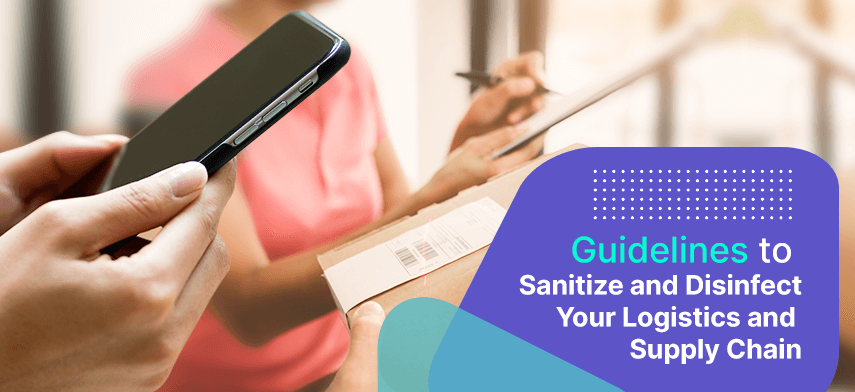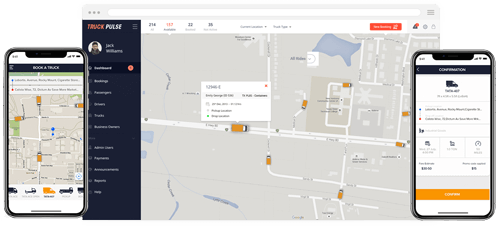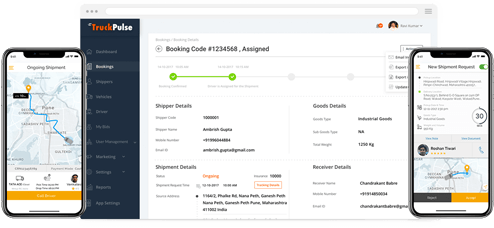Fleet-based industries faced great changes during the COVID-19 pandemic. Due to the nature of its business, sanitation and safety are the top priority. The logistics and supply chain safety quickly adjusted to the new normal. Let’s start with how the logistics and transportation industry implemented these changes into their business.

The Need behind Sanitization and Disinfection for the Fleet Industry
Fleet management systems faced serious confrontations during COVID-19, as businesses were at a standstill. It was indeed a dire need to impose safety and precautionary measures for the employees in charge of deliveries and supply. The need of the hour is to thoroughly apply the safety and sanitation procedures that have been introduced in new policies. The employees and workers in the transportation and logistics industries have to be out on the road to make timely deliveries to their patrons. With the global lockdown, it was necessary to start thorough disinfecting procedures to reduce the risk of contamination for those on the go.
The pandemic did scare us for a certain amount of time, till we got some positive solutions. Fleeting industries have a high-risk job, which requires them to protect themselves through rigorous sanitation and disinfection during this pandemic. The safety protocols for sanitation are put in place to reduce the risk of exposure. These healthcare regulations by the Centre for Disease Control and Prevention are considered to be of top priority for both workers and patrons for their health and wellbeing. We’ll be highlighting the different ways fleeting companies have made sanitation an essential part of their workforce.
Methods and Practices to Follow for Sanitation and Disinfection
For any practice to be introduced in the daily routine, a set of policies must be distributed to those working these shifts. They are aware of the precautions they have to take as they take the road for their services and maintain the same regularly. Let’s talk about some of these methods and practices implemented in the fleeting companies:
Primary Hygiene and Cleanliness:
Operators and employers of fleet companies carry out their business practices within their vehicles. To lower the risk of contamination, regular sanitation practices are put into place. This method helps operators work in a clean zone. Carrying sanitizers and cleansing equipment is a bonus. Drivers and customers seek assurance when it comes to vehicle inspection requirements.
Regular cleaning reduces the chance of any bacteria or virus being attached to the vehicles. Spray solutions, standard cleaning wipes reduce the accumulation of dirt and germs from the vehicle. Seeing a clean and sanitized vehicle ensures both customers and employees understand that your company does look into the essential details for the safety and well-being of them.
Guideline Training Provided to Employees and Suppliers:
This is the perfect opportunity to build closer business strategies with your operators. Educate them regarding the new policies and guidelines which are introduced. Communicate with them directly and allow them to update you with any of their problems. Keep a tab on daily sanitary inspection of vehicles and provide them with constructive feedback. This will enhance them to take these precautionary measures seriously.
Separate Vehicles for Every Fleet Operator:
Assigning separate vehicles to fleet operators increases efficiency in maintaining the safety and cleanliness guidelines set by the company. Operators easily comply with the sanitation guidelines as they provide fleet safety solutions.
This results in workers taking responsibility for the sanitation of the vehicle and their well-being. Separate vehicles have an added benefit as well. Since drivers aren’t sharing the space with anyone else, the risk of contamination decreases. Every fleet-operator needs to follow the new policies put in place by the company.
Masks, Sanitizers, Gloves - The Pandemic Essentials:
Whether you are a customer, employee, employer, or an operator, make sure that these pandemic essentials are what you surround yourself with. Being in the trucking and fleet business, you will be encountering people on your daily rendezvous. Being on the road is a risk in itself, wearing a mask protects you from the germs and viruses. Sanitize your hands every time you touch any surface or shake a hand. It is advised that even if you are wearing disposable gloves, make sure they are well sanitized and thrown away at the end of the working hours. These essentials contribute to fleet safety management.
Safety Measures through Spray Application Solutions:
Spraying solutions are a blessing. These solutions make it easy for fleeting companies for a quick cleansing for their vehicles. It is essential that these solutions are EPA and CDC approved, as they have a certain set of guidelines for these solutions. These approved sprays kill bacterias, germs, and viruses most of the time, but can prove to be directly toxic to the operators or the customers. Different sprays have different applications. Some dry off easily, others need a cleanse before someone can enter the vehicle. It is suggested that spray solutions that are applied in the interiors must be after thorough cleansing has been done with other sanitation protocols.
Digital Checklist:
Maintaining a fleet management service is in itself a task. For the operator, their vehicles become their workspace for 8-10 hours. One of the best adaptations in the supply chain industry has been the complete digitization of all possible protocols. Digital checklists are one more method one can add to the list of compliance. This way, instead of handwritten maintenance checks, fleet operators can easily check off their tasks for the day while on their phones. Digital checklists also ensure complete sanitation of vehicles as well as a thorough check-up of the machine. For a post and pre-trip transportation safety services include:
- Placement and evaluation of equipment
- Fluid levels of the vehicle in check
- Keeping a check on the alignment of the mirrors and wipers of the vehicle
- Proper sanitation of all the areas that come into contact: windows, seats, dashboard, steering wheel, gear, control panel, and all the interiors
- Disinfecting the foot floor mats in the vehicle
- Any garbage that has been accumulated in the vehicle, need to be disposed of post-work
A digital checklist will only help the fleet operator maintain the daily routine of sanitation of their vehicles, as per the new company guidelines. Switching to the smartphone during this pandemic provides a better opportunity to keep a track of the day to day activities.
Communication as a Safety Protocol:
Experiencing the safety protocols in hand requires concentration. Understanding the routes and paths to attain thorough sanitation of vehicles as they cover miles when on a trip. Regular sanitation treatments provide complete protection against this deadly virus. One of the common logistics freight solutions has been communication. Committed sanitation takes place when both the company and employees effectively communicate with each other.
When you’re heading a fleet-based company during these challenging times, keep an open-ended communication line with your workforce and patrons. Let them know that they are important and all safety and precautionary measures are being taken for their well-being.
Remote Working to Stay Motivated:
If you’re a fleet manager your work will be confined to your home. You will have your team on the field, without your presence. Applying swift transportation safety will be mandatory in these trying times. Make sure that your task force is kept up-to-date with these safety protocols every day with the leverage of mobile applications. They will require notes of encouragement from your end to cater to their work. This is your leverage as a fleet manager to monitor them efficiently as you can view the real-time data entries.
Protecting Patrons and Employees through Social Distancing:
Social distancing is the best way to steer clear from coronavirus. Being in the fleet industry, safety has already been mentioned as the top priority as operators and employees directly deal with customers. Keeping a minimum of 6-7ft gap proves to be helpful in communication. When customers see that your company is following all the safety protocols that have been mentioned, they gain more trust with your services.
When the fleet companies follow these safety guidelines, they not only safeguard their employees and operators but also their patrons. Being in the transportation and logistics sector can be hectic and heard. These guidelines have made it easier for providing vehicle safety supplies to customers. Adapting to the new normal may have been difficult, but this has improved the safety guidelines for our workforce in the long run.
In Closure:
These guidelines will improve your relationship with your employees. It helps them understand that we are looking out for them during this pandemic, as they take the road to complete the services the company provides. Attaining these guidelines will help achieve future goals for adapting to the new changes and policies as and when they come. Allow fleet-operators to communicate with you freely in case they face any problem or issues. This pandemic has taught us many things, being kind pays off in the long run.
Author's Bio




